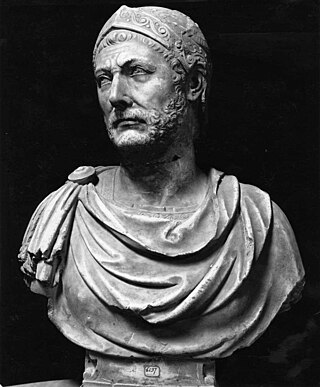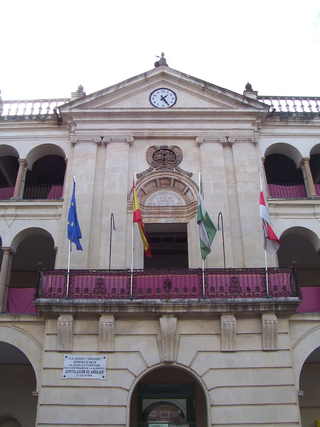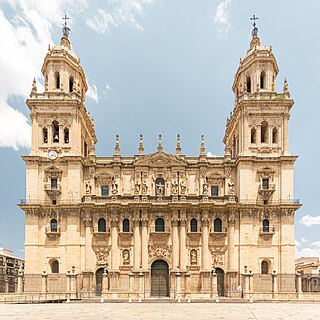Related Research Articles

Hannibal was a Carthaginian general and statesman who commanded the forces of Carthage in their battle against the Roman Republic during the Second Punic War.
Hamilcar Barca or Barcas was a Carthaginian general and statesman, leader of the Barcid family, and father of Hannibal, Hasdrubal and Mago. He was also father-in-law to Hasdrubal the Fair.
Mago Barca was a Carthaginian, member of the Barcid family, who played an important role in the Second Punic War, leading forces of Carthage against the Roman Republic in Iberia and northern and central Italy. Mago was the third son of Hamilcar Barca, was the brother of Hannibal and Hasdrubal, and was the brother-in-law of Hasdrubal the Fair.

Hasdrubal Barca, a latinization of ʿAzrubaʿal son of Hamilcar Barca, was a Carthaginian general in the Second Punic War. He was the brother of Hannibal and Mago Barca.

Andújar is a Spanish municipality of 38,539 people (2005) in the province of Jaén, in Andalusia. The municipality is divided by the Guadalquivir River. The northern part of the municipality is where the Natural Park of the Sierra de Andújar is situated. To the south are agricultural fields and countryside. The city proper located on the right bank of the Guadalquivir and the Madrid-Córdoba railway. In the past, Andújar was widely known for its porous earthenware jars, called alcarrazas or botijos, which keep water cool in the hottest weather, and were manufactured from a whitish clay found in the neighbourhood.

The Battle of Jerez took place in 1231 near the southern Spanish city of Jerez de la Frontera during the Reconquista. King Ferdinand III of Castile and León's troops fought against those of Emir Ibn Hud of the taifa of Murcia. The Castilian forces were led by Ferdinand's brother, Prince Alfonso de Molina, assisted by Álvaro Pérez de Castro; according to some accounts Castro led the Castilians, not Molina. The battle is traditionally seen as marking the collapse of Ibn Hud's authority, and allowing the rise of his successor, Muhammad I.

Ilipa or Ilipa Magna was an ancient Iberian city located on the right bank of the River Betis within one of its meanders. It later became part of the province of Hispania Ulterior and the legal district of Hispalis. Today, its remains can be found in the municipality of Alcalá del Río, in the province of Seville, Spain.

Hasdrubal the Fair was a Carthaginian military leader and politician, governor in Iberia after Hamilcar Barca's death, and founder of Cartagena.

The Roman Republic conquered and occupied territories in the Iberian Peninsula that were previously under the control of native Celtic, Iberian, Celtiberian and Aquitanian tribes and the Carthaginian Empire. The Carthaginian territories in the south and east of the peninsula were conquered in 206 BC during the Second Punic War. Control was gradually extended over most of the peninsula without annexations. It was completed after the end of the Roman Republic, by Augustus, the first Roman emperor, who annexed the whole of the peninsula to the Roman Empire in 19 BC.

Lucentum, called Lucentia by Pomponius Mela, is the Roman predecessor of the city of Alicante, Spain. Particularly, it refers to the archaeological site in which the remains of this ancient settlement lie, at a place known as El Tossal de Manises, in the neighborhood of Albufereta.

The Assumption of the Virgin Cathedral is a Renaissance-style, Roman Catholic cathedral located in Santa María Square, opposite the Town Hall and the Episcopal Palace, in the center of Jaén, region of Andalusia, Spain.

The Germani were an obscure pre-Roman ancient people of the Iberian Peninsula which settled around the 4th century BC in western Oretania, an ancient region corresponding to the south of Ciudad Real and the eastern tip of Badajoz provinces.
Hamilcar's victory with Naravas took place in 240 BC in what is now north-west Tunisia. A Carthaginian army led by Hamilcar Barca defeated a rebel army led by Spendius and Autaritus, after 2,000 Numidian cavalry led by Naravas defected from the rebels to Carthage. The precise location of the battle is unknown. Carthage was fighting a coalition of mutinous soldiers and rebellious African cities in the Mercenary War which had started in 241 BC.
This section of the timeline of Hispania concerns Spanish and Portuguese history events from the Carthaginian conquests to before the barbarian invasions.

Manuel Canaveris was an Argentine army officer, who took part in the defense and reconquest of Buenos Aires during the English Invasions. He served under Colonel Ignacio Álvarez Thomas in the 4th Regiment of Buenos Aires, participating in the Campaigns to the Interior of the Provinces of 1810.

Warfare in ancient Iberian Peninsula occupied an important place in historical chronicles, first during the Carthaginian invasion of Hispania, including the Punic Wars, and later during the Roman conquest of the peninsula. The densely bellicose character of the Pre-Roman peoples who inhabited Hispania was repeatedly shown in their conflicts against Rome, Carthage and each other.
Larus was a leader of Cantabrian mercenaries in the Carthaginian army during the Second Punic War, according to Silius Italicus's poem Punica.

Mercenary life is recorded as a custom of Iron Age Spain, particularly in the central area of the Iberian Peninsula. Departing from the native tribe and applying to serve in others was a way for economically disadvantaged youth to escape poverty and find an opportunity to use their fighting skills. Starting from 5th century BC, mercenary life would become a true social phenomenon in Hispania, with great numbers of fighters from distant lands coming to join the armies of Carthage, Rome, Sicily and even Greece, as well as other Hispanic peoples.
Orissus or Orisson was a chief, leader or ruler of the Iberian Oretani.
Indortes was an Iberian warlord from the first half of the 3rd century BC. He succeeded Istolatios in command of the Turdetan and Iberian revolt against the Carthaginians of Hamilcar Barca.
References
- ↑ Sánchez-Barba, Mario Hernández (1995). España: historia de una nación. Madrid: Editorial Complutense. ISBN 84-89365-34-2.
- ↑ García-Osuna y Rodríguez, José María Manuel (2007). "La segunda guerra romano-púnica y el gran Aníbal Barca" (pdf). Boletín del Instituto de Estudios Giennenses (195). Jaén: Instituto de Estudios Giennenses: 63. ISSN 0561-3590.
- ↑ Roldán Hervás, José Manuel; Wulff Alonso, Fernando (2001). Citerior y Ulterior: las provincias romanas de Hispania en la era republicana. Tres Cantos: Ediciones Istmo. ISBN 84-7090-333-0.